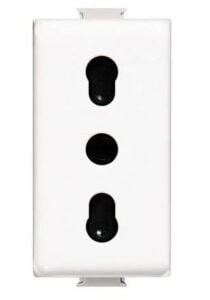Electrical sockets are not all the same, although they all serve the same purpose. In this post we will show you how many and which types exist on the market.

Electrical sockets, often considered simple terminals of an electrical system, are actually the tip of an iceberg of complexity and functionality. Behind the different conformations that we can observe are in fact technical characteristics and regulations that it is important to know about.
In this article, we will explore the various types of electrical sockets, distinguishing their features and functions.
Indice:
- P10: Italian socket
- Distant pins and 16A current: the P11 socket
- P17/11 Socket: two-pole socket
- P40 Schuko-Socket: German socket
- Recommended sockets
If you would like to discover the range of electrical sockets from the best brands, you will find all the sockets mentioned below in our section on Covers and switches
P10: Italian socket
The P10 socket, shown in the picture, is the standard Italian socket found in most homes.
The socket is characterised by three closely spaced input pins and can support a maximum current of 10A, corresponding to a power of approximately 2200W.

Please note: It is important not to use adapters to connect 16A sockets to the P10 socket.
This is because such a connection could cause an overload of current and power, with the risk of accidents and damage to the electrical system.
Distant pins and 16A current: the P11 socket
The P11 socket, at first glance, might appear to be the twin of the classic P10 socket. Both are equipped with three round holes and fit perfectly into the standard plates of Italian installations. But on closer inspection, a fundamental difference emerges: the P11 socket is designed to handle higher power loads.

Distinctive features:
- Maximum current: The P11 socket can support a maximum current of 16A, compared to 10A for the P10
- Power: As a result, the P11 is capable of delivering a power of around 3500W, almost twice as much as the 2200W of the P10
- Pins: The distance between the pins of the P11 is slightly larger than that of the P10. This detail not only distinguishes the two types, but also prevents the use of 16A socket adapters in P10 sockets, ensuring the safety of the system
P17/11 Socket: two-pole socket
The P17/11 socket, also known as a bivalent or two-pin socket, is the most popular choice in modern electrical installations. Its versatility makes it an ideal solution for various needs.
Features:
- Universal compatibility: The P17/11 socket is compatible with both 10A (P10) and 16A (P11) plugs. This means that any type of household appliance can be connected, without the need for adapters or multiple sockets
- Safety:The P17/11 socket has built-in safety systems that prevent overheating and the risk of short circuits. In addition, the presence of a grounding hole guarantees protection against electrocution
- Compact design:the P17/11 socket takes up the same space as a P10 socket, making it ideal for installation in standard sockets
Advantages:
- No need for adapters:Compatibility with plugs of different amperage makes the P17/11 socket a versatile and practical solution
- More safety:Integrated security systems ensure the protection of people and property
- Ease of use:Use is intuitive and requires no special knowledge


P40 Schuko-Socket: German socket
Schuko sockets, also known as P40, differ from standard sockets in form and function. They accommodate so-called ‘German’ plugs, equipped with two flat side contacts for earthing.
Schuko sockets are mainly used for high-powered appliances such as ovens, air conditioners, refrigerators and water heaters, providing greater safety for the system. They occupy two modules in a frame, requiring more space than standard sockets.

There are different types of Schuko sockets:
- Universal: allows the insertion of both Schuko and standard 10A plugs (such as P17/11)
- With switch: equipped with a button to switch the power on and off
- Coloured: green or red to identify the electrical circuit to which they are connected
Schuko sockets offer more safety and power for demanding appliances, making them a recommended choice for a safe and reliable electrical installation.
Installation requires a qualified electrician.
Recommended sockets
In practical use, P30 and P17/11 sockets (i.e. both 10A and 16A) are always recommended.
In this way, it is always possible to connect both a ‘large’ and a ‘small’ socket on a single electrical outlet.
The remaining P10 and P11 sockets are, to date, not always the most chosen by customers.
You might also be interested in:
